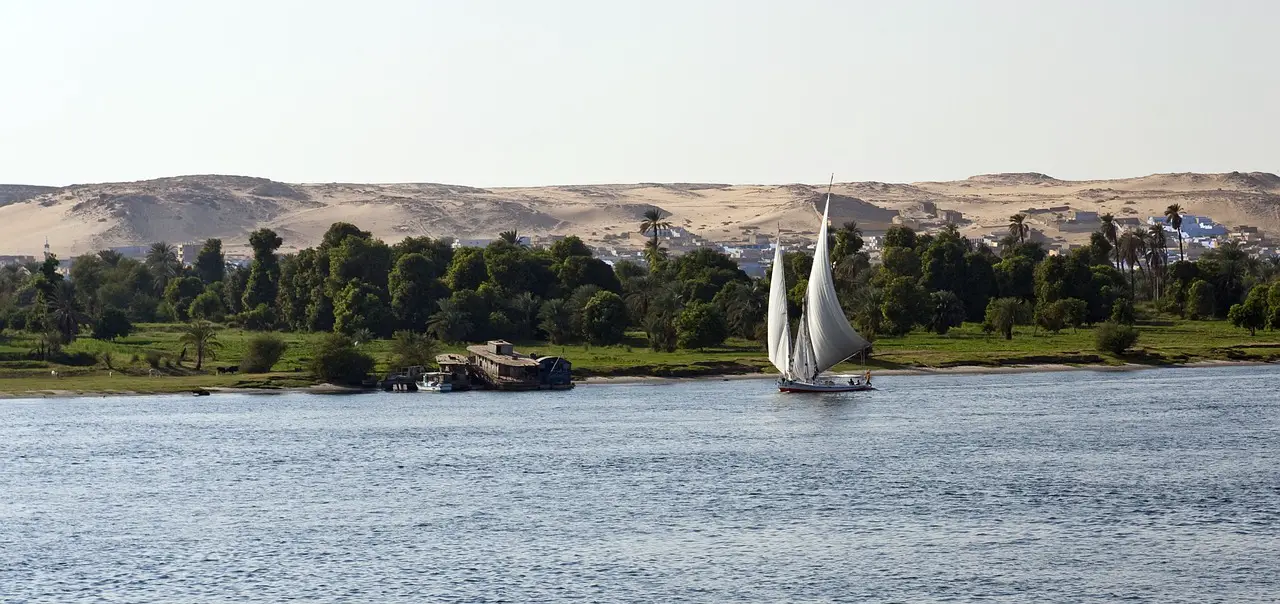
The Nile River is one of the world’s most iconic and historically significant bodies of water. For centuries, it has been the lifeline of Egypt, shaping the country’s culture, economy, and way of life. But where is the Nile River located, and what makes it so unique? In this article, we will explore the geography, history, and significance of the Nile River.
Table of Contents
What Is The Nile River?
The Nile River is a major north-flowing river in northeastern Africa. It is approximately 6,695 kilometers (4,160 miles) long, making it the longest river in the world. The Nile River is formed by the confluence of two major tributaries: the White Nile and the Blue Nile. The White Nile originates in Burundi and flows through Rwanda, Tanzania, Uganda, and South Sudan before joining the Blue Nile in Khartoum, Sudan. The Blue Nile originates in Ethiopia and flows through Ethiopia and Sudan.
The White Nile is the longer of the two branches. The Blue Nile, on the other hand, is the source of most of the water and sediment that flows into the Nile River.
Where Is The Nile River Located?
The Nile River flows through eleven countries in northeastern Africa, including Burundi, Congo-Kinshasa, Egypt, Ethiopia, Kenya, Rwanda, South Sudan, Sudan, Tanzania, Uganda, and Eritrea. However, the majority of the river’s length and discharge is concentrated in just two countries: Sudan and Egypt.
Significance Of The Nile River
The Nile River has played a significant role in the development of civilization in northeastern Africa. The river’s fertile floodplain, known as the Nile Valley, has been inhabited for thousands of years and is home to some of the world’s oldest and most advanced civilizations, including the ancient Egyptians, Nubians, and Kushites.
The Nile River has also been a critical source of water for agricultural activities in the region. The river’s annual flood cycle, caused by the monsoon rains in East Africa, provides a reliable source of water for irrigating crops and replenishing soil nutrients. This enabled the people living along the Nile River to cultivate a variety of crops, including wheat, barley, cotton, and sugarcane.
In addition to its agricultural significance, the Nile River has also played a crucial role in transportation and trade. The river has been used for transportation since ancient times, with the Egyptians and Nubians using boats and barges to transport goods up and down the river. Today, the Nile River is still a vital transportation route for goods and people in northeastern Africa.
Challenges Facing The Nile River
Despite its historical and cultural significance, the Nile River faces many challenges that threaten its sustainability. The increasing demand for water resources in the region, coupled with climate change and human activities such as dam construction, has led to water scarcity and environmental degradation in some areas.
One of the most significant challenges facing the Nile River is the construction of the Grand Ethiopian Renaissance Dam (GERD) in Ethiopia. The dam, which is expected to be the largest hydroelectric power plant in Africa, has been a source of tension between Ethiopia and downstream countries such as Egypt and Sudan, who fear that the dam will reduce the flow of water downstream.
Conclusion
In conclusion, the Nile River is a significant body of water that has played a crucial role in the development of civilization and agriculture in northeastern Africa. Its historical, cultural, and economic significance cannot be overstated. From the ancient Egyptians to modern-day farmers, the Nile River has been essential to the growth and prosperity of the region.
Despite being a crucial water source for millions of people, the Nile River is facing various challenges. Climate change, population growth, and pollution are threatening the river’s ecosystems and the livelihoods of those who depend on it. As such, we must take steps to protect and preserve the Nile River and its resources.
Overall, the Nile River is a remarkable natural wonder with a rich history and culture. Its location in northeastern Africa has shaped the region’s development and played a crucial role in the lives of millions of people. By understanding the significance of the Nile River, we can appreciate its importance and take action to protect it for generations to come.